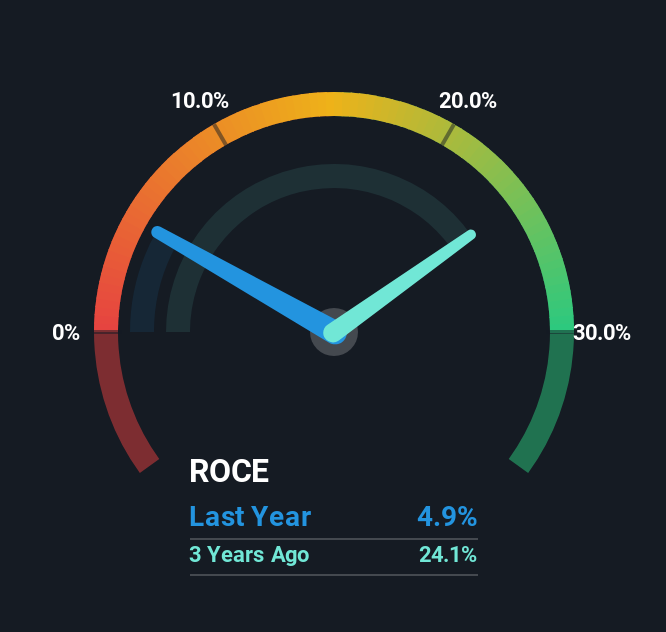L&P Global Berhad (KLSE:L&PBHD) Is Reinvesting At Lower Rates Of Return
If you're not sure where to start when looking for the next multi-bagger, there are a few key trends you should keep an eye out for. Ideally, a business will show two trends; firstly a growing return on capital employed (ROCE) and secondly, an increasing amount of capital employed. Basically this means that a company has profitable initiatives that it can continue to reinvest in, which is a trait of a compounding machine. However, after briefly looking over the numbers, we don't think L&P Global Berhad (KLSE:L&PBHD) has the makings of a multi-bagger going forward, but let's have a look at why that may be.
Return On Capital Employed (ROCE): What Is It?
Just to clarify if you're unsure, ROCE is a metric for evaluating how much pre-tax income (in percentage terms) a company earns on the capital invested in its business. The formula for this calculation on L&P Global Berhad is:
Return on Capital Employed = Earnings Before Interest and Tax (EBIT) ÷ (Total Assets - Current Liabilities)
0.049 = RM6.4m ÷ (RM140m - RM9.7m) (Based on the trailing twelve months to June 2025).
So, L&P Global Berhad has an ROCE of 4.9%. Ultimately, that's a low return and it under-performs the Packaging industry average of 6.6%.
See our latest analysis for L&P Global Berhad

Historical performance is a great place to start when researching a stock so above you can see the gauge for L&P Global Berhad's ROCE against it's prior returns. If you want to delve into the historical earnings , check out these free graphs detailing revenue and cash flow performance of L&P Global Berhad.
What Does the ROCE Trend For L&P Global Berhad Tell Us?
When we looked at the ROCE trend at L&P Global Berhad, we didn't gain much confidence. Over the last five years, returns on capital have decreased to 4.9% from 27% five years ago. Given the business is employing more capital while revenue has slipped, this is a bit concerning. This could mean that the business is losing its competitive advantage or market share, because while more money is being put into ventures, it's actually producing a lower return - "less bang for their buck" per se.
On a side note, L&P Global Berhad has done well to pay down its current liabilities to 6.9% of total assets. That could partly explain why the ROCE has dropped. What's more, this can reduce some aspects of risk to the business because now the company's suppliers or short-term creditors are funding less of its operations. Since the business is basically funding more of its operations with it's own money, you could argue this has made the business less efficient at generating ROCE.
Our Take On L&P Global Berhad's ROCE
From the above analysis, we find it rather worrisome that returns on capital and sales for L&P Global Berhad have fallen, meanwhile the business is employing more capital than it was five years ago. Investors haven't taken kindly to these developments, since the stock has declined 65% from where it was year ago. Unless there is a shift to a more positive trajectory in these metrics, we would look elsewhere.
If you'd like to know more about L&P Global Berhad, we've spotted 4 warning signs, and 2 of them are significant.
While L&P Global Berhad isn't earning the highest return, check out this free list of companies that are earning high returns on equity with solid balance sheets.
New: AI Stock Screener & Alerts
Our new AI Stock Screener scans the market every day to uncover opportunities.
• Dividend Powerhouses (3%+ Yield)
• Undervalued Small Caps with Insider Buying
• High growth Tech and AI Companies
Or build your own from over 50 metrics.
Have feedback on this article? Concerned about the content? Get in touch with us directly. Alternatively, email editorial-team (at) simplywallst.com.
This article by Simply Wall St is general in nature. We provide commentary based on historical data and analyst forecasts only using an unbiased methodology and our articles are not intended to be financial advice. It does not constitute a recommendation to buy or sell any stock, and does not take account of your objectives, or your financial situation. We aim to bring you long-term focused analysis driven by fundamental data. Note that our analysis may not factor in the latest price-sensitive company announcements or qualitative material. Simply Wall St has no position in any stocks mentioned.
About KLSE:L&PBHD
L&P Global Berhad
Offers integrated industrial packaging solutions in Malaysia and Vietnam.
Excellent balance sheet with slight risk.
Market Insights
Community Narratives


Recently Updated Narratives

Constellation Energy Dividends and Growth

CoreWeave's Revenue Expected to Rocket 77.88% in 5-Year Forecast

Bisalloy Steel Group will shine with a projected profit margin increase of 12.8%
Popular Narratives


MicroVision will explode future revenue by 380.37% with a vision towards success


NVDA: Expanding AI Demand Will Drive Major Data Center Investments Through 2026



